|
|
|
Sort Order |
|
|
|
Items / Page
|
|
|
|
|
|
|
| Srl | Item |
| 1 |
ID:
111803
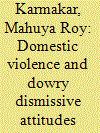

|
|
|
| 2 |
ID:
113859
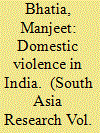

|
|
|
|
|
| Publication |
2012.
|
| Summary/Abstract |
After prolonged lobbying, the Protection of Women from Domestic Violence Act of 2005 was implemented in India in October 2006. The Act soon gave rise to cases. This article is based on a preliminary study using questionnaire-based interviews of litigants in Delhi who were involved in cases under the Act. Primary data, taken from all the Delhi Metropolitan Magistrates Courts at that time, concern the background of those who used the law, the litigation process, implementation of the law and the forms of violence addressed. The article seeks to assess the effectiveness of this new legislation and examines specifically what kinds of people bring actions under this new gender-specific law. In addition, qualitative assessment of the perceptions of different kinds of violence by complainants and respondents provides deeper insights into ongoing and potential contestations over gender-based violence.
|
|
|
|
|
|
|
|
|
|
|
|
|
|
|
|
| 3 |
ID:
127082
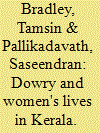

|
|
|
|
|
| Publication |
2013.
|
| Summary/Abstract |
This article presents new knowledge on the link between dowry and instances of abuse against newly married women. It draws on data collected during structured and in-depth interviews and focus groups involving 60 women in Kerala. The data argue that despite decades of campaigning by women's groups' dowry is still widely practised. Furthermore, the links between dowry, harassment and violence remain. The qualitative analysis of the data reveals how most people hold complex and seemingly contradictory views on dowry. Placing these views along a continuum with 'dowry is a problem' and 'dowry is necessary' at each end enables a picture to emerge of why dowry remains hard to eradicate. Most informants were clear that dowry represents a key problem for women; they also said they would continue to give dowry because it was the only way to secure a 'good' marriage. The data did reveal cracks in the patriarchal system; young women were direct identifying dowry as the main problem they faced. Also, indifferent views were voiced by younger men suggesting they may not forcefully act to maintain the system. Opportunities do exist to push wider holes in the system which could in turn spark the transformation still needed.
|
|
|
|
|
|
|
|
|
|
|
|
|
|
|
|
| 4 |
ID:
076320
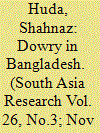

|
|
|
|
|
| Publication |
2006.
|
| Summary/Abstract |
Marriage negotiations for Bangladeshi Muslims involve various financial transactions including primarily the religiously sanctioned dower (mahr). Added to mahr, the practice of dowry or joutuk, demands made by the husband's side to the bride's side, have in the last few decades become a widespread practice supported neither by state law nor personal laws, but apparently designed to strengthen traditional patriarchal assumptions. Based on detailed fieldwork, this article discusses the historical assimilation of dowry practices in Bangladesh, including debates regarding its social ramifications on women's rights in Bangladesh, linked now to growing evidence of dowry-related violence. The existing dowry practices, despite legal intervention, continue to compromise women's rights in Bangladesh.
|
|
|
|
|
|
|
|
|
|
|
|
|
|
|
|
| 5 |
ID:
121837
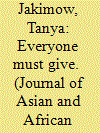

|
|
|
|
|
| Publication |
2013.
|
| Summary/Abstract |
Bridegroom price is extracting a heavy toll on the poor in rural Telangana, Andhra Pradesh, India. Poor households are becoming indebted and losing assets to pay the increasing amounts demanded by grooms at the time of their daughters' weddings. Bridegroom price is a relatively recent phenomenon in the area, first practiced amongst scheduled and backward caste groups less than two decades ago. This article draws upon practice theory and cultural neo-institutionalism to offer an alternative explanation for the emergence and persistence of bridegroom price as a time, space and socially specific institution. Using empirical material from in-depth qualitative interviews in two villages in Telangana, Andhra Pradesh in 2010, it suggests that bridegroom price emerged as a result of shifts in the subjectivities of low-caste men, and in particular the evaluation of the self in relation to the social whole. The article seeks to contribute to existing explanations for bridegroom price and dowry, while also arguing that theoretically informed approaches are necessary in order to develop effective measures to combat these institutions.
|
|
|
|
|
|
|
|
|
|
|
|
|
|
|
|
| 6 |
ID:
132270
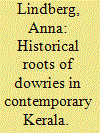

|
|
|
|
|
| Publication |
2014.
|
| Summary/Abstract |
Dowry payments from the family of the bride to that of the groom were rarely encountered in Kerala during the early twentieth century, but now are almost universal. Based on an examination of historical documents, including legislative debates, court cases, and reports, the way dowry was explained in the past is compared with the results of 200 contemporary interviews to determine its current rationale. Nowadays, making an obligatory payment for the maintenance of a wife, adherence to a social norm, and guaranteeing a woman's good treatment have displaced earlier arguments related to inheritance, status in the social hierarchy, or a woman's ability to provide for herself. Although several blurred traditions have been cited to account for dowries, they seem to have flourished in times of social inequity and uncertainty: the 1930s, 1970s, and 1990s. The emphasis on patriarchal nuclear families has created a mentality that a woman must pay for the privilege of being married and living securely.
|
|
|
|
|
|
|
|
|
|
|
|
|
|
|
|
| 7 |
ID:
130731


|
|
|
|
|
| Publication |
2014.
|
| Summary/Abstract |
The gendered character of India's fertility decline has attracted considerable academic attention. In this paper, I offer a critique of the arguments of some demographers about the linkages between dowry, daughter aversion and the marriage squeeze that predict that increasing shortages of marriageable women will result in declines in dowry. I argue that such economistic readings seriously oversimplify the complexities of marriage arrangement 'on the ground' in contemporary India. Further, whilst one aspect of dowry might relate to the supply and demand of brides and grooms, dowry and daughter aversion are not simply outcomes of demographics alone. First, marriage migration is crucial in understanding daughter aversion. Second, dowry is not just a matter of marriage and kinship practices. Dowry is a polyvalent institution that also connects with conspicuous display in status competition in a hierarchical society and with people's rising aspirations to possess consumer goods within the wider context of contemporary India's rapidly changing political economy. Crucially, marriage migration, status competition and consumerism do not necessarily push in the same direction as the demographics of the marriage squeeze might imply when it comes to dowry and daughter aversion.
|
|
|
|
|
|
|
|
|
|
|
|
|
|
|
|
|
|
|
|
|